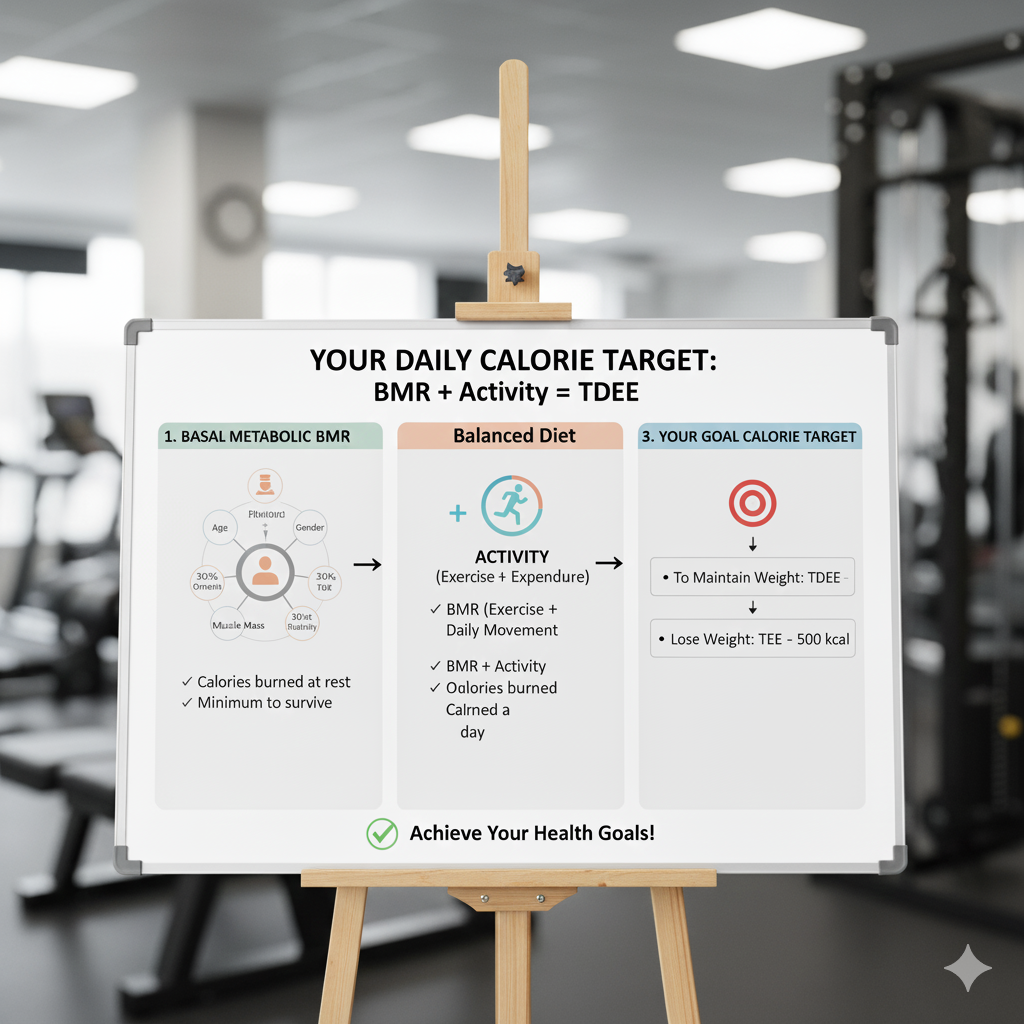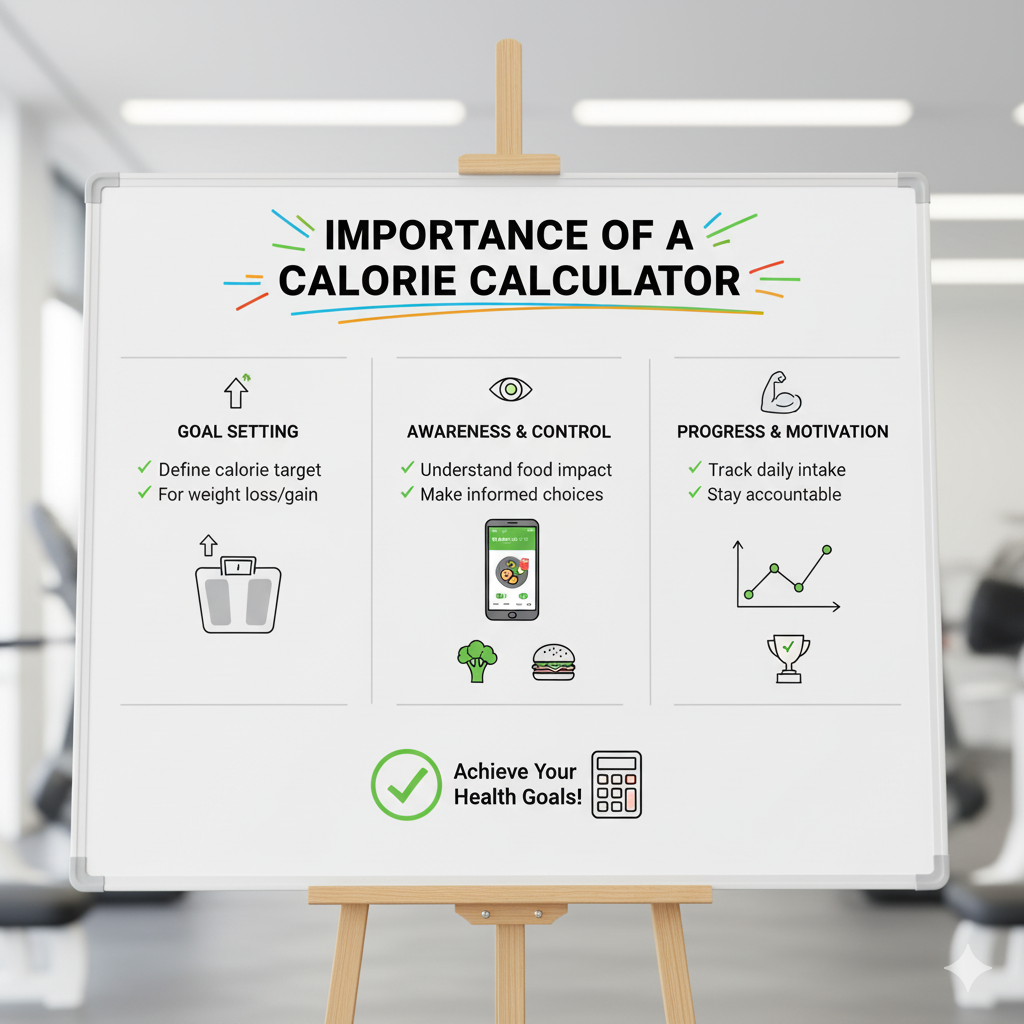The Calorie Calculator Masterclass: Eat Smarter, Track
Easier, Progress Faster
Master your nutrition with precision calorie calculations and sustainable strategies
Calories are the currency of bodyweight change: when you spend more than you take in you lose weight, and when
you take in more than you spend you gain weight. But real-world success depends on measurement,
personalization, and iteration—not one-size-fits-all rules. Use our
Calorie
Calculator
together with the BMR
Calculator, Macro
Calculator, and Body Fat Calculator to make targets that actually fit your
lifestyle. This guide teaches you how to translate caloric numbers into sustainable habits.
Why Calories Matter — And Why They Don't Tell the
Whole Story
Calories drive energy balance, but the composition of those calories—protein, carbohydrates, and
fats—determines body composition, satiety, and performance. Two people on the same calorie target can
experience opposite outcomes depending on macros, training, sleep, and NEAT (non-exercise activity
thermogenesis).

Same calories, different macros = different results
- Calories = energy: The math of weight change comes from the calories-in vs
calories-out relationship.
- Macros shape composition: Protein preserves muscle, carbs support training, and fats
support hormones and satiety.
- Behavior wins: Adherence, not perfect math, determines outcomes over months.
How This Calculator Works
Our tool starts by estimating your resting energy (BMR) then factors in activity and exercise to estimate
your Total Daily Energy Expenditure (TDEE). From TDEE you can choose a sensible deficit, maintenance, or
surplus tailored to your objective. Use the calculator outputs as a testable hypothesis—not an immutable
law.
For example, after calculating TDEE you may set a 10–20% calorie deficit for steady fat loss, or a 5–12%
surplus for lean muscle gain. Always pair caloric changes with appropriate protein and a consistent
training strategy; see the Macro Calculator.
Step-by-Step: From BMR to a Usable Calorie Target
Turning a BMR number into an actionable daily plan requires a few clear steps. Follow this sequence for
reliable results:
- Calculate BMR: Use the BMR Calculator to get your resting baseline.
- Estimate activity: Pick an activity multiplier based on your job, exercise frequency,
and non-exercise movement to find TDEE.
- Choose a goal: Deficit for fat loss (~10–20%), maintenance for stability, or a small
surplus for muscle gain (~5–12%).
- Set macros: Prioritize protein (to protect lean mass) and then set carbs and fats using
the Macro
Calculator.
- Track and tweak: Monitor weekly averages for weight, waist, and performance, and re-run
calculators every 2–4 weeks or after ±2–3 kg of change.
Choosing a Deficit or Surplus: Practical Rules
The size of your calorie shift should match your timeline, starting point, and willingness to tolerate
hunger or fat gain. A few guidelines:
- Beginner or returning trainee: Smaller deficits (10–15%) are safer, and recomposition
(some fat loss while gaining muscle) is possible with intense training.
- Experienced trainee: Slower, more conservative deficits preserve strength—aim 8–12
weeks with small adjustments.
- Rapid timelines: If you must lose faster, accept higher risk of hunger, decreased
training quality, and increased muscle loss—use careful protein and resistance training to mitigate loss.
- Muscle gain: Small surpluses reduce fat gain while enabling progress—track via monthly
checks and body fat estimates with the Body Fat Calculator.
Macro Prioritization: Where Calories Should Come From
After setting your calorie target, allocate calories to macros to support training and health. Protein is
the non-negotiable priority:
- Protein: 1.6–2.4 g/kg of target bodyweight (higher for aggressive deficits or those
aiming to build muscle while losing fat). Use the Macro Calculator for exact splits.
- Fats: Keep adequate intake (usually ≥20–25% of calories) to support hormones and
satiety.
- Carbohydrates: Fill remaining calories; tailor around training to fuel performance and
recovery.
Example Allocation
For a 2,200 kcal maintenance plan aimed at fat loss (15% deficit → ≈1,870 kcal): set protein to 150 g (600
kcal), fats ~25% (~470 kcal ≈ 52 g), remainder to carbs (~800 kcal ≈ 200 g). Exact numbers should be
tailored with the Macro Calculator.
Tracking Methods: From Simple to Scientific
Tracking doesn't need to be all-or-nothing. Choose an approach you can sustain:
- Calorie logging: Use a food scale and a tracking app for accuracy, especially during
learning phases.
- Portion control: Useful for long-term habit maintenance—learn the basics using your
calorie plan and then switch to portion cues.
- Visual checks & photos: Weekly photos and performance metrics can be just as
instructive as the scale when used together.
- Periodic audits: Log for 7–14 days every 4–8 weeks to check for drift vs your calorie
target.
Solving Common Problems
When progress stalls, small diagnostics often find the issue. Try this troubleshooting checklist:
- Audit intake: Track everything honestly for 7–10 days—liquids, cooking oil, restaurant
meals often hide calories.
- Check NEAT: Has your daily movement dropped? If so, add structured steps, standing
breaks, or short walks.
- Assess training: Reduced training intensity or volume can stall progress—prioritize
progressive overload for recomposition or preservation of muscle.
- Sleep & stress: Poor sleep increases appetite and reduces recovery; prioritize 7–9
hours where possible.
- Recalc TDEE: If you've lost or gained 2–3 kg, rerun the Calorie
Calculator and adjust.
Practical Protocols (Examples You Can Use)
8-Week Fat Loss Protocol
- Start with a 12–15% deficit from TDEE (calculate with our tool).
- Protein: 1.8–2.2 g/kg; resistance training 3x/week; 8–12k steps/day.
- Track weight weekly averages, waist, and performance; adjust calorie target if trend stalls.
12-Week Lean Bulk
- Start with a 6–10% surplus; prioritize progressive overload; measure body fat monthly.
- Protein: 1.6–2.0 g/kg; carbs scaled on training days; small monthly adjustments to calories to keep
fat gain minimal.

From BMR to your personalized calorie target
Behavioral Tips to Stay Consistent
Precision matters less than consistency. A few practical nudges:
- Plan meals: Batch-cook proteins and vegetables to reduce decision fatigue.
- Protein first: Include a protein source at each meal to increase satiety.
- Hydration & fiber: Support fullness and digestion with water and fiber-rich foods.
- Track weekly: Log or photograph your meals for 1–2 weeks every month to catch drift.
How to Use This Tool With Other Calculators (SEO
Interlinking)
Use the BMR
Calculator for resting estimates, the Macro Calculator to allocate protein/carbs/fat, the Body Fat
Calculator to track composition improvements, and the BMI Calculator for a quick population-level check. For broader
reading, consult our Nutrition
Guide and Weight Loss
Guide.
Ready to Set Realistic Calorie Targets?
Calculate your TDEE, choose a goal, set macros, and test the plan for 4 weeks.
Learn more: Nutrition Guide • Weight Loss Guide • Fitness Guide


